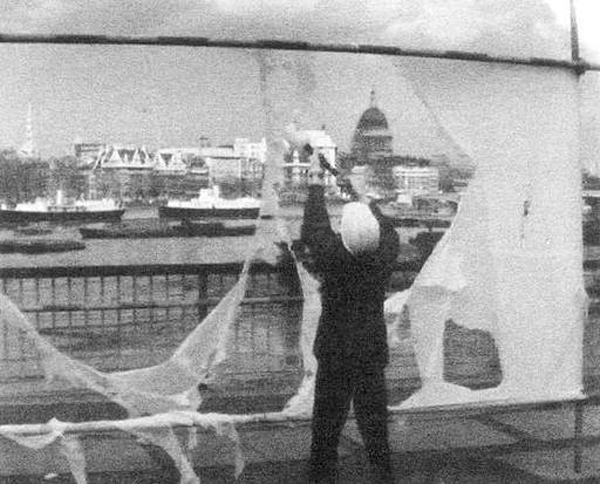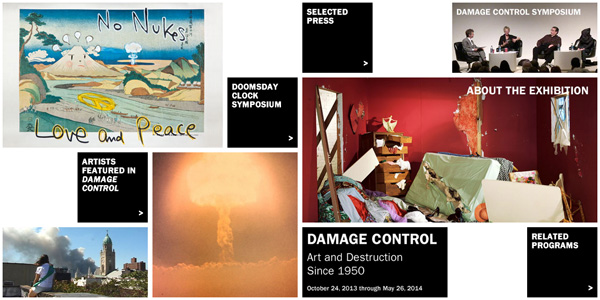Are nuclear explosions art? Anyone who has taken even a glance into modern and contemporary art knows that the official mantra might as well be “anything goes,” but I found myself wondering this while visiting the exhibition “Damage Control: Art and Destruction since 1950” that is currently at the Hirshhorn Museum. The first thing one sees upon entering is a juxtaposition of two very different sorts of “work.” On the right is a fairly long loop of EG&G footage of nuclear test explosions, broadcast in high definition over an entirety of a wall. On the left is a piano that has been destroyed with an axe. This, I thought, is at least a provocative way to start things off.
Edgerton, Germeshausen, and Grier (EG&G) was a contractor for the federal government during the Cold War, responsible for documenting nuclear test explosions. Quite a lot of the famous Cold War nuclear detonation footage was taken by EG&G. They are perhaps most famous for their “Rapatronic” photographs, the ultimate expression of MIT engineer Harold “Doc” Edgerton’s work of slowing down time through photography, but this was only a part of their overall contribution. The film they have at the Hirshhorn is something of an EG&G “greatest hits” reel from the 1950s, and its affect on the others in the audience was palpable. Adults and children alike were drawn to the blasts, displayed one after another without commentary or explanation.1 Their reactions didn’t strike me as one of disgust or horror, but of amazement and awe. Most of the footage was from the Nevada Test Site, so the bombs were generally just blowing up desert scrub, and occasionally houses constructed for effects testing.
The destroyed piano, by contrast, got reactions of shock and disgust. It was the remains of a piece of performance art conducted by Raphael Montañez Ortiz, one of several he’s done, apparently. My wife, a piano player and a nuclear historian, also found it disturbing. “If you know what goes into making a piano…,” she started to say. “But then again, if you know what goes into making a city…,” she caught herself. I overheard other people say similar things.
The difference in reactions isn’t too surprising — it’s a common theme that it is easy to appreciate the destruction of something at a human scale, difficult to appreciate it at the scale of nuclear bomb. A lot of what I’ve spent time doing, with the NUKEMAP and my writing, is to try to understand, and to impart, the scale of a nuclear explosion. A lot of this has involved looking at the attempts of others, as well, from official Cold War visualizations made for secret committees to popular films, as they have tried to communicate this to their target audiences. The hardest thing is that our brains appear only to be wired for empathy at the individual level, and don’t readily apply it to large groups or large areas. The best work in these areas conveys both the broad scope of destruction, but then ties it into the personal. They individualize the experience of mass ruination.
And the EG&G footage isn’t trying to do that. It was data meant for very specific technical purposes. It was developed in order to further the US nuclear program, and defense against Soviet nuclear weapons. Which is why I somewhat question its inclusion, or, at least, its decontextualization. It is art only in the sense that it has aesthetics and it has been put into an art gallery. One can read into it whatever one wants, of course, but it wasn’t created to have deep meaning and depth in that sense. (Whether one cares about authorial intention, of course, is its own can of modern art worms.) Just as a small example of what I mean, Andy Warhol famously made a print of mushroom clouds for his own “disaster” series (a few of which, but not this print, were featured in the exhibit):
Now Warhol is a complicated character, but since he was explicitly an artist I think it is always fair game to talk about his possible intentions, the aesthetics of the piece, the deeper meanings, and so on. Warhol’s art has generally been interpreted to be about commercialization and commodification. The mushroom cloud in repetition becomes a statement about our culture and its fascination with mass destruction, perhaps. Coming in the mid-1960s, after the close-call terrors of the early years of the decade, perhaps it was maybe too-little too-late, but still, it has an ominous aesthetic appeal, perhaps now more than then.
Because I don’t think this image was widely circulated at the time, I doubt that Warhol knew that Berlyn Brixner, the Trinity test photographer, had made very similar sorts of images of the world’s first nuclear fireball at “Trinity”:
Brixner appreciated the aesthetics and craft of his work, to be sure. But the above photograph is explicitly a piece of technical data. It is designed to show the Trinity fireball’s evolution over the 15-26 millisecond range. Warhol’s instrument of choice was the silkscreen printer; Brixner’s was the 10,000 fps “Fastax” camera. There’s a superficial similarity in their atomic repetition. You could make a statement by putting them next to each other — as I am doing here! — but properly understood, I think, they are quite different sorts of works.
Don’t get me wrong. Re-appropriating “non-art” into “art” has been a common move over much of the 20th century at the very least. But the problem for me is not that people shouldn’t appreciate the aesthetics of the “non-art.” It’s that focusing on the aesthetics makes it easy to lose sight of the context. (As well as the craft — Brixner’s work was exponentially more difficult to produce than Warhol’s!) The EG&G footage in the exhibit doesn’t explain much of how, or why, it was made. It seems to be asking the viewer to appreciate it solely on its aesthetic grounds. Which I think is the real problem. Many of the tests they show resulted in significant downwind fallout for the populations near the Nevada Test Site. Many of them involved the development of new, ever-more elaborate ways of mass destruction. Many of them were the product of years of top scientific manpower, untold riches, and a deep political context. To appreciate them as simply big, bright booms robs them of something — no matter how aesthetically beautiful those big, bright booms actually are.
What makes it more ironic is that the exhibit actually does give considerable context to some of the works that are explicitly “art.” You have to explain the context of Gustav Metzger’s “auto-destructive” art — it involves him filming himself painting on canvases with a strong acid, so the artwork destroys itself in the process. Without the context there, what is left is just a boring, not-very-comprehensible movie of a man destroying a blank canvas. But anyway.
In terms of the audience at the exhibit, which was fairly well-attended when I was there with my wife, the most interesting part was the handling of children. The Smithsonian museums are of course explicitly places that people take their children while visiting the city, so it’s no surprise that you probably find more of them at the Hirshhorn than you would at MOMA or other similar institutions. But children add a level of anxiety to an exhibit about destruction. They were wowed by the wall-o’-bombs but not, it seemed, by the piano. Parents seemed to let them wander free through most of it, but there were several films where I saw kids get yanked out by their parents once the parents realized the content was going to be disturbing. In one of these films, the “disturbing” content was of a variety that might have been hard for the children to directly understand — the famous film of the Hindenburg going up in flame, for example, where the violence was real but seen from enough of a distance to keep you from seeing actual injuries or bodies. The one I saw the kids getting really removed from (by their parents, not the museum) was footage of the 2011 Vancouver riots. I wasn’t impressed too much with the footage itself (its content was interesting in a voyeuristic way, but there seemed to be nothing special about the filming or editing), but the immediacy of its violence was much more palpable than the violence-at-a-distance that one saw in most of the other such works. It’s cliche to trot out that old quote attributed (probably wrongly) to Stalin that one death is a tragedy, a million is a statistic, but there’s something deeply true to it about how we perceive violence and pain.
There are a lot of works in the exhibit. As one would expect, some hew to the theme very closely, some are a bit more tenuous. Overall, though, it was pretty interesting, and if you’re in town, you ought to check it out. The original comment my wife made about pianos and cities stuck with me as I looked at all of the various meditations on “destruction.” In it, I kept coming back to the second law of thermodynamics. On the face of it, it is a very clinical, statistical law: “the entropy of an isolated system never decreases.” It is actually quite profound, something that the 19th-century physicists who developed it knew. Entropy can be broadly understood as “disorder.” The second law of thermodynamics says, in essence, that without additional energy being put into it, everything eventually falls apart. It takes work to keep things “organized,” whether they are apartments, bodies, or cities.2 Ludwig Boltzmann, who helped formulate the law, stated gnomically in 1886 that:
The general struggle for existence of animate beings is not a struggle for raw materials – these, for organisms, are air, water and soil, all abundantly available – nor for energy, which exists in plenty in any body in the form of heat Q, but of a struggle for [negative] entropy, which becomes available through the transition of energy from the hot sun to the cold earth.
In other words, life itself is a struggle against entropy. Our bodies are constantly taking disordered parts of the world (heat energy, for example, and the remains of other living things) and using them to fuel the work of keeping us from falling apart.
But the other way to think about this law is that generally it is easier to take things apart than it is to keep them together. It is easier to convert a piano into a low-energy state (through an axe, or perhaps a fire) than it is to make a piano in the first place. It is easier to destroy a city than it is to make a city. The three-year effort of the half-a-million people on the Manhattan Project was substantial, to be sure, but still only a fraction of the work it took to make the cities of Hiroshima and Nagasaki, and all that they contained, biological and material, in the first place.
Of course, the speed at which entropy increases is often controllable. The universe will eventually wear out — but not for a long time. Human civilization will necessarily go extinct — but it doesn’t have to happen anytime soon. What hits home with the “Damage Control” exhibit is how we as a species have to work so hard to keep everything together, while simultaneously working so hard to find ways to make everything fall apart. And in this, perhaps, it is a success, even if I left with many niggling questions about the presentation of some of the works in particular.
- Various guys in the audience would occasionally try to give explanation to their loved ones, and they were generally incorrect, alas. “That must be at Alamogordo… That’s got to be an H-bomb…” no, no, no. Of course, I was there with my wife, and I was talking up my own little storm (though less loudly than the wrong guys), but at least I know my stuff for the most part… [↩]
- The key, confusing part about the second law is the bit about the “isolated system.” It doesn’t say that entropy always increases. It says that in an isolated system — that is, a system with no energy being input into it — entropy always increases. For our planet, the Sun is the source of that input, and you can trace, through a long series of events, its own negative entropy to the Big Bang itself. [↩]







Harold Edgerton may have been no Andy Warhol, but there is a certain unselfconscious artfulness in the setup and presentation of nuclear weapons tests, and later in his career, Edgerton made many more self-consciously arty photographs of high-speed phenomena. The Hirshhorn’s presentation of the “greatest hits” video is even more artful. The floor-to-ceiling screen is just large enough that the fireballs and mushrooms tower over us, yet at an animal scale, like the biggest baddest bear from the darkest folk tale ever told, and intimately close, within a darkened room. No matter how familiar you think you are with this material, unless you actually witnessed one of these tests in person, you will come away newly impressed.
I think this exhibit is less about treating nukes and car crashes as “found art” and more about the image in art and culture of technological violence and disaster in general, and the nuclear threat in particular. The aesthetics of these images, as well as their emotional impacts, are surely appropriate things to consider in this context. Conversely, the videos of confrontations between protesters and police contextualize this contemporary form of human conflict within the matrix of technology. We know, after all, that it is theater for the camera, the whole world watching, or not.
I certainly agree that much of Edgerton’s work was purposefully “artful” — especially his “normal” work he did at MIT. But I don’t see much purposeful art about the EG&G footage. I see a very clinical, technical gaze. It produces tremendous output, to be sure. And you can project that on a wall in a very pretty matter. But that doesn’t really get around the issue I’m addressing here. You could make a stunning wall exhibit of my tax return as well, but that wouldn’t mean it was ever intended to be “art.” One can, as always, say that everything is art once you put it into a museum, but I think that is too easy of an intellectual shortcut these days. I think stripping out the real-world context and replacing it with an art-context is somewhat problematic.
The exhibit is about the image of technological violence and disaster, the image in art and culture and its impact on society. Going back to the source material (and presenting it in a very artful way) to evoke the context does not seem so problematic to me. If that makes the exhibit less pure art and more a hybrid with social/political observation (or even commentary), what seems more of a problem to me is the lack of other museum spaces in which such material could be presented. Perhaps some of it belongs more in Air & Space. Well, we saw what happened in 1995.
What hits home with the “Damage Control” exhibit is how we as a species have to work so hard to keep everything together, while simultaneously working so hard to find ways to make everything fall apart.
—One of the weirder things that I heard is the modern buildings, those built in the 20th century, wear out faster when neglected than the older ones did / do.
—The ease of putting them up is matched by the ease of tearing them back down.
—Obviously, a lot of buildings made 150 years ago were badly made, and were torn down in their time, as well. But it feels wrong to see wooden homes made in the 1880s, and think how many “McMansions” are made each year that are probably going to be seen as temporary installations by comparison.
I live in a 19th century building. My city, in the 1960s, infamously tore down entire communities of these buildings and replaced them by concrete tower blocks. The latter are now being demolished on a monthly basis, whilst the Victorian buildings are some of the most sought-after housing in the city.
I think there is another problem with trying to explain the history of the early nuclear era to a modern person. The problem is one of distance, namely time. Most younger people today cannot truly understand the level of threat everyone felt back in the simpler times of the Cold War, when the enemy was easily painted as a polar opposite of ourselves and had the capacity to destroy us. Thus, even if you can educate people on what happened then, it still never quite becomes real. It’s like trying to understand what it was like during the time of the Revolutionary War or the Civil War. All we have are pictures, paintings and writings. We don’t have the ability to actually experience the times.
Alex,
I have not seen the Hirshhorn exhibit.
Are you aware that on Dec 4 the Wikipedia article on Operation Crossroads (written mostly by me) was Today’s Featured Article on the main page? It normally gets 600 page views per day, but on Dec 4 it got 74,600. I am especially impressed by the image of a battleship standing on its nose, like the Washington Monument. It was a unique piece of performance art.
Howard: Congrats! Crossroads featured a bit in the exhibit, incidentally — Ralston Crawford made some terrible impressionist drawings of the tests that appeared in Fortune magazine. Apparently he even felt they were inadequate. Here is one of them. I guess that’s a ship getting blown up.
I once had the idea for a film where a man who participates in one of the “human” testing of the atomic bombs where he grows aesthetically fascinated by the explosion, and starts chasing them around, taking photographs of them, and growing increasingly obsessed. He is eventually irradiated at Castle Bravo when he gets too close
I truly believe that yes, Atomic bombs are one of the most significant “artistic” objects we’ve ever seen. Their visual fascination is justified perhaps by the exceptionally fast macro size processes we’re looking at. We’re used to seeing most of what happens during an atomic explosion, but not so much, in such a short amount of time. The nuclear explosions in space, and their recordings are almost hypnotically beautiful, just in terms of color and the way they expand.
Perhaps in the future, when we’ve left the planet, we’ll have artists like the one you cite, but instead of destroying a piano they will create mountain ridges on distant planets using nuclear weapons.
It is posts like this that keep me coming back to this blog. Always detailed, and always insightful.
Whenever I see a new post on Nuclear Secrets, I know that I’m in for a good read.
Of course, the speed at which entropy decreases is often controllable.
Are you sure this is what you want to say? For the universe entropy only increases. Locally one can decrease entropy (using energy) but entropy wins in the end. Seems to me given everything else in the article I would have written “Of course, the speed at which entropy _increases_ is often controllable”. But perhaps you are making a more subtle point?
Ah, yes, just a typo. Fixed.
I think there is an important popular cultural dimension to the aesthetics of violence, especially nuclear violence. Nuclear weapons, or at least the threat of nuclear weapons, are a common trope in movies, TV, video games, comic books, etc. Nuclear explosions in these works are not uncommon. Of course, the way that nuclear explosions are dealt with varies from work to work: the deus ex machina at the end of The Avengers, destroying the alien invaders; the kitschy Survival City-esque nuclear test in Indiana Jones 4 that borders on slapstick; the surprisingly poignant first-person death scene in Call of Duty 4, staring up into a mushroom cloud.
At a certain point, though, I think people’s response to attempts to examine violence in high art is going to be conditioned at least in part by the more popular cultural dimensions of violence. Nuclear explosions are a stock trope of a good portion of contemporary fiction. Perhaps if falling pianos were rehabilitated as a common slapstick trope, people’s reaction to a smashed-up piano would be less intense.
The piano destruction concert could have been spiced up by having a concert pianist play a difficult classical piece while the ax guy does his thing. Hearing the elegant and structured sounds getting warped into nothingness as entropy has it’s way would impress on one how fragile organized activity actually is.
There is a short story, entitled “Goodbye Houston Street, Goodbye” by Richard Kadrey, which is summarised on LibraryThing (by AlanPoulter) as follows:
Parnell is dumped by Jessie for a fellow artist, Dix. Parnell decides to steal the show at Dix’s art exhibition to win back Jessie. However his ‘entry’ leaves a lasting impression on the whole of Manhattan but only takes second place. Very dark humour.
It originally appeared in Interzone 19 in 1986, but I read it in one of the Interzone anthologies sometime in the late 1980s or early 1990s. It has stayed with me all that time.
As a lad, I once read (where? Reader’s Digest, maybe?) that a fad among college students was to start with a board bearing a hole six inches in diameter, an upright piano, and using appropriate tools in the fastest possible time, render the piano into small pieces, passing the entire piano through the hole.
For some reason this made a deep impression on me. However, when I arrived at college, I learned that nobody there wanted any part of such a contest. Guess the fad had passed.
I should have told them it was Art.
Well it’s picky but I also was wondering how you reconcile the statement that “life itself is a struggle against entropy” with the large entropic term in the free energy of ATP hydrolysis, for example. Actually, life is channeled entropy production. In fact, there is evidence that in economics, at least, and perhaps in politics and culture as well, the healthiest state is one of near-maximal entropy, and that lower entropy states (e.g. fascism, orthodoxy, oligarchy) are pathological.
Nice post, Alex. this exhibit is on my list of things to do when in DC next.
I know my answer, but then again I have this hanging on my wall:
http://www.flickr.com/photos/rocbolt/11485539825/